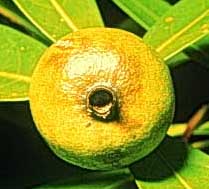
Alibertia edulis (Rich.) A. Rich.
Trompillo
(Rubiaceae)
 |
Alibertia edulis (Rich.) A. Rich. Trompillo (Rubiaceae) |
Masís, A., Guadamuz, A., Chavarría, F., Espinoza, R. and Perez, D. 1998. Alibertia edulis (Rubiaceae) Species Page, January 7, 1998. Species Home Pages, Area de Conservación Guanacaste, Costa Rica. http://www.acguanacaste.ac.cr
I. Identification:
Tree or shrub up to 5.5 m tall (Croat 1978).
Flower:
This is a dioicious species. The inflorescences are terminal, sessile or subsessile and white (Croat 1978).
Fruit:
The fruits are berries from 3-5 cm in diameter.
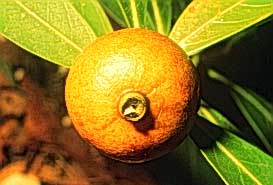 |
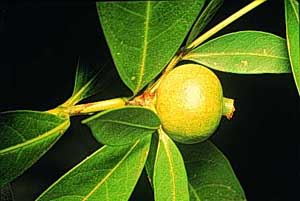 |
The fruits are green when immature and brown when mature.
The mesocarp (the inside part of the fruit; the pulp) is bland with a bitter flavor.
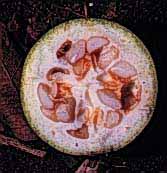 |
 |
Transversal cuts of the fruit immature, partially mature and mature | |
The seeds are flat. They change from white when immature to light brown when mature.
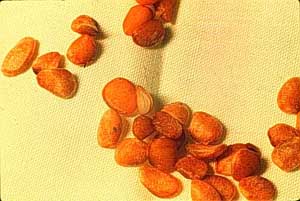 |
Leaves:
The leaves are simple and opposite; they are lanceolate in form and glabrous on both sides. The upper surface is dark green and the under surface is light green. They have intrapetiolar stipules.
|
Upper side of leaf |
Umder side of leaf |
|
Detail of the under side |
Detail of the upper side |
Stipule |
The margin is entire. The length of the leaves varies from 5 to 14 cm; the petiole is approximatly 0.5 cm long.
Some of the new leaf shoots are green and some are light purple.
They are abundant (2-4 per square meter) in some sites.
Bark and wood:
The bark of Alibertia edulis has a fine reticulate and is light brown in the older parts.
The young branches are reddish between nodes. A transversal cut reveals cream colored wood.
|
Cross section |
External bark |
Whole plant architecture:
It is abundant in some areas (2-4 per square meter).
|
Habitat |
Similar species:
Verification:
II.Geographic distribution:
International:
Alibertia edulis is found from Mexico to the Amizon basin. It is also found in Bolivia, Trinidad and Tobago (Croat 1998)
In Costa Rica:
In the Area de Conservación Guanacaste:
This species is as common in dry forest habitat as in the wet forest.
Map of macro-habitats of the
ACG |
III. Natural History:
Its the classic Rubiaceae along with Exostema, both are capable of withstanding droughts. Calycophyllum and Guettarda also, but these are species that occur in less altered forest.
IV. How to find:
In the Santa Rosa Sector it is possible to find in the Bosque Húmedo and Bosque San Emilio. Also in the El Hacha Sector near the Los Almendros station.
Acknowledgments:
This project was carried out by the Area de Conservación Guanacaste/CR, with help from INBio/CR, ICBG from the Foggarty center, NIH/USA and NSF/USA.
Thanks to Kate Beattie for helping with the managment of images and translation of this species page.
Literature cited:
Croat, T.B. 1978. Flora of Barro Colorado Island. Standford University Press, Standford.